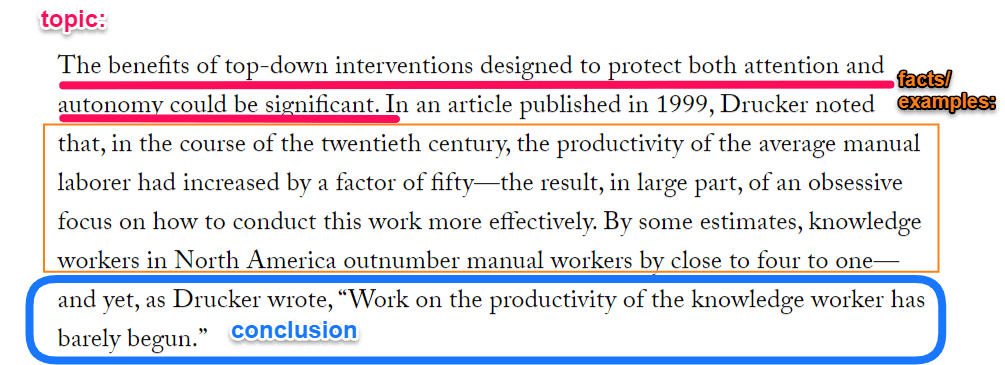Your primary school teacher may have told you that one paragraph should contain no more than 5-6 sentences. Others might have later told you it shouldn’t be more than 200 words.
But are these rules valid on the internet? And is length even an accurate measurement of a ‘good’ paragraph, or is it about effectively communicating your ideas?
In this article, I will share some guidelines to help you decide the length of your paragraphs. You’ll also learn when these guidelines can be disobeyed and a few common paragraph writing mistakes to avoid. Let’s get started with answering the question first.
How Many Sentences Are in a Paragraph?
A paragraph generally has 3 to 10 sentences. Classical authors opted for longer sentences, so even one sentence could have made a paragraph. Educators may like to see paragraphs that are at least 5 sentences. But on the web, writers use short sentences and even under 3 sentences may do — because of the short attention spans of readers.
Ultimately you want a paragraph to coherently convey your argument. You want your idea to be lucidly explained to the readers.
When Should You Start a New Paragraph?
When you feel you have completed your thought or conveyed an idea thoroughly, then you can start a new paragraph. Sometimes though, you may have a HUGE idea that demands multiple paragraphs. You can transition to a new paragraph during a minor idea shift in such cases.
In cases of dialogue writing, you can start a new paragraph every time a new person speaks.
Guidelines to Write A Paragraph That Readers Love in 2023
Here are three pointers to help you decide about your paragraph lengths. Of course, no point on the list is hard and fast — and applicable 100% of the time. Bend these “rules” as you need – especially when you are trying out new and creative endeavors in your writing practice.
1. Aim For 3-5 Sentences Per Paragraph
Yep, 3-5 is the number of sentences in a paragraph you can *generally* shoot for.
However, this guideline is often broken in various forms of writing — and even appreciated by the reader.
For example, news writers frequently only write one sentence per paragraph for greater impact, and the effect is truly welcomed.
Take, for instance, the BBC news article’s snapshot below about India’s mission to Mars. There are multiple paragraphs with only one sentence, and the piece holds its ground beautifully.

However, in most forms of writing, your teachers weren’t wrong in telling you to stick to an ideal 3-5 sentences per paragraph. The true motive behind this rule is to enhance the readability of your paragraphs and improve their effectiveness.
On the internet, I wouldn’t read a blog with a paragraph length being 8-10 sentences. In a novel, I would.
So how many sentences does a paragraph need?
Well, it’s based on your audience’s preferences and the platform you are writing for.
And hey, the answer to “How many lines should a paragraph have?” is also the same. Typically, while writing for the web, don’t go beyond 3-4 lines in a paragraph. But if you’re writing for a different platform, possibly shooting for up to 8 lines can also work.
2. Have A Definite Structure In Your Paragraphs Here
Even here, the academicians came to the rescue. They were right in telling us to have one topic (or controlling idea) per paragraph – beginning with a topic sentence, facts/examples supporting that core idea, and a concluding sentence.

Again, this isn’t a magic formula for writing all your paragraphs. It isn’t ideal or even possible to have every paragraph with this structure. But, aim for it most of the time. It will give your paragraphs an aesthetic proportion, natural flow, and smoothness.
3. Make The Transition From One Paragraph To the Next Smooth
Tie up the loose ends in your paragraph with great care. One paragraph should ideally blend perfectly into the next. Otherwise, the next paragraph might come as a surprise and seem off-track. Often transitions are natural conclusions to one core idea or conjunctions that relate the previous paragraph to the next one.
Paragraph Writing Mistakes To Avoid
Apart from following the rules, you also need to keep an eye on common mistakes you might make. These are avoidable, simple to catch, but often overlooked.
1. More Than One Controlling Idea in One Paragraph
It can be confusing for readers to have more than one idea. If your paragraph talks about two or three controlling topics, consider eliminating sentences related to the second idea, and putting it in another paragraph. Overly complicated paragraphs also might lose your reader’s attention.
Consider this horrendous paragraph with multiple controlling ideas jumbled up together:
“August is my favorite month of the year. December is too cold and May too hot. If you talk about days, I love the Thursday of every week. Especially because of the closeness to Friday and the distance from Monday. The month of August passes so fast, I wish I could catch it for a little while longer. The leaves are my favorite. Especially in the evenings.”
A better way would be to split the paragraph in two:
“August is my favorite month of the year. December can be too cold and May is too hot to be excited. But – August, it is perfect. The leaves are my favorite – especially in the evenings when the sun is setting. August passes so fast, I wish I could catch it for a little while longer. And if you talk about days, nothing beats Thursday. It is closest to Friday and farthest from Monday — it is the thing I love most about Thursday!”
Now the paragraph makes much more sense and the transition only seems to add to the flow. Talk about only one thing in one paragraph – it is the easiest way to enhance your writing’s readability.
It can be confusing for readers to have more than one idea. If your paragraph talks about two or three controlling topics, consider eliminating sentences related to the second idea, and putting it in another paragraph. Overly complicated paragraphs also might lose your reader’s attention.
Consider this horrendous paragraph with multiple controlling ideas jumbled up together:
“August is my favorite month of the year. December is too cold and May too hot. If you talk about days, I love the Thursday of every week. Especially because of the closeness to Friday and the distance from Monday. The month of August passes so fast, I wish I could catch it for a little while longer. The leaves are my favorite. Especially in the evenings.”
A better way would be to split the paragraph in two:
“August is my favorite month of the year. December can be too cold and May is too hot to be excited. But – August, it is perfect. The leaves are my favorite – especially in the evenings when the sun is setting. August passes so fast, I wish I could catch it for a little while longer. And if you talk about days, nothing beats Thursday. It is closest to Friday and farthest from Monday — it is the thing I love most about Thursday!”
Now the paragraph makes much more sense and the transition only seems to add to the flow. Talk about only one thing in one paragraph – it is the easiest way to enhance your writing’s readability.
2. Uneasy Transition to The Next Paragraph
Sometimes transitions are helpful within a single paragraph to account for an easy read. To ensure a logical progression between paragraphs, use single words or short phrases that relate a paragraph to the previous one.
Consider this paragraph about books:
“The reason I love books is that they engage so many of my senses – I am not just reading through my eyes, I can feel the sounds presented by the author in my ear, and can almost taste the boiling tea in my mouth. It feels too hot.
What movies might miss is capturing me in the picture and transporting me to somewhere I am not. I cannot live multiple lives through movies, but by books, it seems I do.”
While the two paragraphs above are related, the reader cannot grasp how one idea jumped to the next. Consider this, where the transition is much smoother:
“The reason I love books is that they engage so much of my senses – I am not just reading through my eyes, I can feel the sounds presented by the author in my ear, and can almost taste the boiling tea in my mouth. It feels too hot. It feels like I am living multiple lives from my sofa as I browse the pages.
And this is what the movies miss. They don’t capture my senses and transport me into another world, another life. Here, I can’t live multiple lives.”
Now, wasn’t that much better?
The relationship between one paragraph and the next is crucial in ensuring a logical flow to your ideas. Each paragraph should show how it relates to the broader argument.
3. Lack Of A Core Idea In The Paragraph
A structure (as discussed in point two of the Rules) ensures that your paragraph is not all over the place. A paragraph with no controlling idea can get messy and confuse your readers.
Consider the same example we used in point one:
“August is my favorite month of the year. December is too cold and May too hot. If you talk about days, I love the Thursday of every week. Especially because of the closeness to Friday and the distance from Monday. The month of August passes so fast, I wish I could catch it for a little while longer. The leaves are my favorite. Especially in the evenings.”
It is unclear what the author is talking about here. Is it about a favorite month, or a favorite day, or the relation between them? Splitting them into two, as done in point one, ensures that the paragraph maintains one topic and smoothly relates to the paragraph that follows.
Final Thoughts
Paragraphs can be your best friends to hold your reader’s attention. Use it to your advantage by following simple rules:
- aiming for only 3-5 sentences/paragraph,
- having a definite structure, and a smooth transition,
- and avoiding common mistakes: lack of a core idea in the paragraph or having too many, and an uneasy transition from one paragraph to the next.
